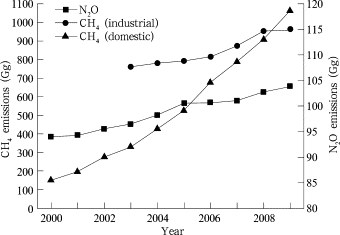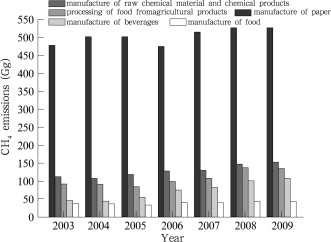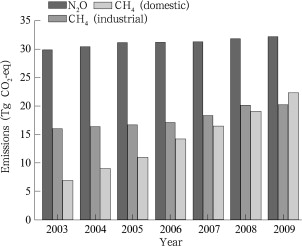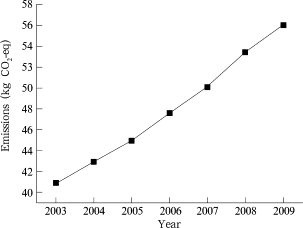Abstract
Based on the statistics from the China Statistical Yearbook (2000–2009) on environment and methods recommended by the IPCC, the amounts of greenhouse gas (GHG) emissions from domestic and industrial sewage treatment in China are estimated for the period of 2003–2009. CO2 emissions per capita from sewage treatment plants are also analyzed. The results show that the GHG emissions from sewage treatment plants increased steadily from 2003 to 2009; N2 O emissions from domestic sewage are the major source of the total GHG emissions from domestic sewage; CH4 emissions from domestic sewage increase with the greatest speed; CH4 emissions from paper and pulp industry are the major source of industrial sewage emissions; CO2 emissions per capita increase constantly from 2003 to 2009.
Keywords
sewage treatment ; CH4 ; N2 O ; emissions
1. Introduction
According to the IPCC Fouth Assessment Report [ IPCC, 2007 ], the rising greenhouse gas (GHG) concentration in the atmosphere is one of the major causes of global warming [ Qin et al., 2007 ]. Sewage treatment plants are one of the significant sources of GHG emissions [ Sahely et al., 2006 ]. Sewage treatment includes both industrial and domestic sewage treatment. During the sewage treatment, the anaerobic process produces CH4 while nitrogen removal produces N2 O. Both CH4 and N2 O are chemically stable and can stay in the atmosphere for a long period. The Global Warming Potential (GWP) for the 100-year scale of CH4 and N2 O are 21 and 310, respectively [ IPCC , 1996 ], thus their emissions can have a lasting impact on climate [ IPCC , 2007 ]. CO2 emissions from sewage are not considered in the IPCC [2006] , because these are from biogenic origin and should not be included in national total emissions calculations.
Urban sewage disposal in China is great in volume, highly concentrated and widely distributed [ Xie and Wang, 2012 ]. In recent years, as China becomes more conscious about environment protection and energy conservation, the number of urban sewage treatment plants as well as sewage treatment capacity is increasing. In 2008, there were 1,692 urban sewage treatment plants in China, 434 more than the previous year. Generally 57.4% of urban domestic sewage in 2008 is processed, representing an 8.3% increase compared to 2007 [ MEPC, 2010 ]. The growing number of sewage treatment plants inevitably leads to high GHG emissions, posing a significant challenge to managing GHG emissions in the sewage treatment sector. So far, there is little research on GHG emissions by sewage treatment plants in China, with the exception of the NCCC and NDRC [2007] .
In this paper, the authors estimate GHG emissions from sewage treatment plants (CH4 and N2 O from domestic sewage, and CH4 from industrial sewage) based on the methodology outlined in the IPCC [ IPCC, 2000 and IPCC, 2006 ], which are catered to actual conditions in China [ Gao et al., 2006 ]. In addition, the authors discuss the change in CO2 emissions per capita of sewage treatment plants. We believe it will help us to understand the current state of GHG emissions from sewage treatment plants and provide insight on reducing GHG emissions.
2. Data and methods
2.1. Data
The amounts of organic matter removed from sewage and the national population are taken from the China Statistical Yearbook on Environment [MEPC, 2000–2009 ] and China Statistical Yearbook [NBSC, 1995–2010 ], respectively. The protein consumption per capita is quoted from the UN FAO [2010] . The parameters used in estimating GHG emissions primarily refer to the IPCC [2006] and related literatures [ Yang et al., 2005 , Tang et al., 2001 , Cao, 2009 and Song et al., 2012 ].
2.2. Method to estimate CH4 emissions from domestic sewage
It is good practice to use default values of emissions factors and activity parameters to calculate the amount of emissions for countries with limited data [ IPCC, 2006 ]. Due to the lack of research on factors and parameters of GHG emissions from the sewage treatment sector in China, the authors generally used default values suggested by the IPCC. The amount of CH4 emissions is a function of the amount of sewage and the CH4 emissions factor. Any recycled CH4 should be excluded from the total emissions amount. The simplified formula for calculating CH4 emissions from sewage treatment is shown as below:
|
|
( 1) |
where ECH4 is the annual CH4 emissions (in Gg), TOW denotes the total amount of organic matter contained in domestic sewage in a given year (in kg). Since domestic sewage is rarely treated in rural China, we only consider domestic sewage treatment in the urban area. The amount of organic matter in domestic sewage is the product of the amount of chemical oxygen demand (COD) removed from urban sewage (Fig. 1 ) multiplying by a national average BOD/COD of 0.45 [ Song et al., 2012 ]. EF is the emissions factor, which in this paper has a China-specific value of 0.14 [ Song et al., 2012 ]. R is the amount of CH4 (in kg) recycled in a given year. Since China has not initiated CH4 recycling on a large scale, the default value is 0.
|
|
|
Figure 1. Quantity of COD removed from urban sewage from 2000 to 2009 [ MEPC, 2000–2009 ] |
2.3. Method to estimate CH4 emissions from industrial sewage
Large amounts of CH4 are emitted by the industrial sector when industrial sewage, containing high concentration of organic matter, is processed under anaerobic conditions. For calculating CH4 emissions originating from industrial sewage, we need to first identify sectors that are capable of producing a large quantity of CH4 . Few industries, such as food processing industry, and pulp and paper manufacturing industry, may as well have potential to produce massive amounts of industrial sewage. According to the IPCC [2006] , the major sources of industrial sewage that have high potential to emit CH4 are pulp and paper manufacturing, meat processing or butchering, liquor production, organic chemicals production, and food and beverage processing. In contrary, such industrial sectors in China are paper manufacturing, agricultural product processing, raw chemical material and chemical products manufacturing, and food and drinks production. According to the IPCC [2000] , the simplified formula for estimating CH4 emissions from industrial sewage treatment is shown as follows:
|
|
( 2) |
where TOWi denotes the total quantity of organic matter originating from the industrial sector i in a given year. EFi refers to the emissions factor in sector i . Ri is the amount of CH4 recycled in a certain year (in kg). Since China has not initiated CH4 recycling on a large scale, the default value is 0.
The formula for calculating the CH4 emissions factor of industrial sewage is:
|
|
( 3) |
where B0 is the maximum capacity of CH4 production, for which the default value is 0.25; MCF denotes the CH4 correction factor, which is the proportion of sewage being processed by anaerobic treatment. The default values of MCF in industrial sewage are presented in Table 1 .
| Industry | Treating process | MCF | Reference |
|---|---|---|---|
| Paper and pulp | Anaerobic/aerobic treatment | 0.5 | IPCC, 2006 and Cao, 2009 |
| Agricultural products | Sequencing batch reactor | 0.4 | IPCC, 2006 and Tang et al., 2001 |
| Chemical products | Anaerobic/aerobic treatment | 0.5 | IPCC, 2006 and Yang et al., 2005 |
| Food processing | Aerobic treatment | 0.3 | IPCC, 2006 and Tang et al., 2001 |
| Beverage manufacturing | Aerobic treatment | 0.3 | IPCC, 2006 and Tang et al., 2001 |
The amounts of COD removed from industrial sewage for various industries are shown in Table 2 . The COD is the total amount of chemical oxygen demand removed by regional sewage treatment plants or similar collective processing facilities in industrial parks [ MEPC and NBSC, 2008 ]. Since the current industry classification, GB/T4754-2002 implemented after 2002, is different to the old standard, the analysis starts from 2003.
| Year | Manufacture of paper | Manufacture of raw chemical material and chemical products | Processing of food from agricultural products | Manufacture of beverages | Manufacture of food |
|---|---|---|---|---|---|
| 2003 | 4.7710 | 1.1186 | 0.9137 | 0.4565 | 0.3671 |
| 2004 | 5.0208 | 1.0740 | 0.9053 | 0.4397 | 0.3608 |
| 2005 | 5.0160 | 1.1858 | 0.8406 | 0.5451 | 0.3335 |
| 2006 | 4.7514 | 1.2758 | 0.9808 | 0.7453 | 0.4042 |
| 2007 | 5.1482 | 1.2974 | 1.0691 | 0.8145 | 0.3994 |
| 2008 | 5.2665 | 1.4739 | 1.3700 | 0.9980 | 0.4348 |
| 2009 | 5.2700 | 1.5234 | 1.3456 | 1.0695 | 0.4241 |
2.4. Method to estimate N2 O emissions from domestic sewage
The major sources of N2 O emissions are directly from sewage treatment plants and indirectly, when sewage (primarily domestic sewage) is disposed into rivers, lakes or oceans. We consider the direct emissions from the nitrification and denitrification processes at sewage treatment plants as the secondary source of N2 O, because the amount of N2 O emissions is much less than the indirect emissions from sewages [ IPCC, 2006 ]. In addition, such emissions may only concern collective sewage treatment plants with the technology of nitrification and denitrification processes. Therefore, we do not take the direct emissions into account. According to the IPCC [2006] , we can use the following formula to calculate the indirect N2 O emissions from sewage disposal:
|
|
( 4) |
where, P refers to the national population. Fprotein denotes the annual protein consumption per capita (in kg per person per year). The average dietary protein consumption in China is obtained from the FAO [2010] (Table 3 ). The data for average protein consumption in 2008 and 2009 is extrapolated from the linear trend of 2000–2007. FNPR is the proportion of nitrogen in protein, for which we take the default value of 0.16. FNON-CON refers to the factor of non-consumed protein in sewage. Since domestic sewage contains excrements, we consider the value of 1.5. FIND-COM represents the factor of protein in industrial and commercial sewage, for which we take the default value of 1.25. Nsludge refers to the amount of nitrogen removed along with mud; due to the lack of a China-specific value, we take the IPCC [2006] default value of 0. EFeffluent is the emissions factor, for which we take the IPCC default value of 0.005. Lastly, 44/28 refers to the conversion coefficient from kg N2 O-N to kg N2 O.
| Year | 2000 | 2001 | 2002 | 2003 | 2004 | 2005 | 2006 | 2007 | 2008 | 2009 |
|---|---|---|---|---|---|---|---|---|---|---|
| Average protein consumption | 86.2 | 85.9 | 86.5 | 86.8 | 87.8 | 89.4 | 89.1 | 88.9 | 90.0* | 90.5* |
Note:
- . denotes the value is extrapolated based on the linear trend of 2000—2007
Data source: FAO [2010]
3. Results and discussion
3.1. CH4 emissions from domestic and industrial sewage
CH4 emissions from domestic sewage has been rapidly increasing during 2000–2009 (Fig. 2 ). The CH4 emissions increased from 150 Gg in 2000 to 1,063 Gg in 2009, representing an annual growth rate of more than 24%. Such rapid growth rate can be mainly attributed to the large increase in the number and treatment capacity of urban sewage treatment plants from 2000 to 2009. In 2000, there were 315 plants, while there were 2,192 plants in 2009. During this period, the treatment capacity of urban sewage increased from 320,000 t to 7,696,000 t.
|
|
|
Figure 2. CH4 and N2 O emissions from sewage treatment sectors in China during 2000–2009 |
CH4 emissions from industrial sewage increased from 762 Gg in 2003 to 963 Gg in 2009, equivalent to an annual increase rate of 4%, which is much less than the increasing rate from domestic sewage (Fig. 2 ). CH4 emissions from various industry sewage are presented in Figure 3 . It is clear that emissions from paper and pulp industry is much greater than those from the other four industries, representing more than half of the total emissions from all five industries. Thus, paper and pulp production is the primary source of CH4 , followed by raw chemical and chemical product manufacturers. In contrast, the food processers are the smallest source. Beverage manufacturing industry experienced the fastest growth in terms of CH4 emissions; it more than doubled its emissions from 45 Gg in 2003 to 106 Gg in 2009.
|
|
|
Figure 3. CH4 emissions from industrial sewage treatment of the five major sectors in China from 2003 to 2009 |
3.2. N2 O emissions from domestic sewage
N2 O emissions from domestic sewage increased from 94 Gg in 2000 to 104 Gg in 2009, representing a mere annual growth rate of 1.1%. The modest increase from 2000 to 2009 is due to the slow growth in both population and protein consumption per capita.
3.3. CO2 emissions from sewage treatment plants
In order to ensure continuity and comparability with global GHG emissions data, and in accordance with the requirements of the UNFCCC, we refer to the IPCC Second Assessment Report for the GWP of CH4 and N2 O, which are 21 and 310, respectively [ IPCC, 1996 ]. This allows us to convert the amounts of CH4 and N2 O emissions from sewage treatment to CO2 equivalent (CO2 -eq) emissions (Fig. 4 ). We found that GHG emissions from sewage treatment plants have been steadily increasing, from 53 Tg CO2 -eq in 2003 to 75 Tg CO2 -eq in 2009, which represents an annual growth rate of 6%. N2 O from domestic sewage has the greatest CO2 -eq, thus it is the main emissions source. Due to the rapid growth, CH4 emissions from domestic sewage have overtaken CH4 emissions from industrial sewage as the second largest emissions source.
|
|
|
Figure 4. Emissions from sewage treatment sectors from 2003 to 2009 in China |
3.4. CO2 emissions per capita from sewage treatment plants
Based on population data [ NBSC, 1995–2010 ], we can calculate the CO2 emissions per capita from sewage treatment plants (Fig. 5 ). It is found that CO2 emissions per capita from sewage treatment plants have been increasing at an annual rate of 5.4%. This increase can be attributed to the vast rising sewage treatment rate and high living standards.
|
|
|
Figure 5. CO2 emissions per capita from sewage treatment plants in China from 2003 to 2009 |
4. Conclusions
(1) Both CH4 and N2 O emissions from sewage treatment plants have been increasing from 2000 to 2009, while the amount of CH4 emissions are much greater than that of N2 O. In particular, the annual CH4 emissions from domestic sewage are growing at the greatest rate, while N2 O emissions from domestic sewage show the least increase.
(2) Among the five major industries, CH4 emissions from paper and pulp industry accounted for more than half of the total CH4 emissions from sewage treatment, which is the primary source of emissions, followed by raw chemicals and chemical product manufacturing industry. Food processing industry is the least source. CH4 emissions from beverage manufacturing sector are increasing with the greatest rate.
(3) When converting CH4 and N2 O emissions into CO2 equivalent emissions, N2 O emissions from domestic sewage account for about half of the total emissions during 2003–2009, which makes themselves the primary source of emissions. CH4 emissions from domestic sewage have overtaken CH4 emissions from industrial sewage in 2009 to become the second largest source emissions, due to its fast increase rate.
(4) CO2 emissions per capita from Chinese sewage plants have been steadily increasing from 2003 to 2009.
Insufficient statistical data is available in China, particular the data used in estimating GHG emissions. Further, there are no China-specific emissions factors. As a result, it is hard to estimate the actual amount of GHG emissions. We recommend that China should strengthen the research in emissions factors specific to the sewage treatment sector.
Acknowledgements
This research was supported by the GEF/UNDP Second National Communication on Climate Change of China — China’s inventory of GHG emissions from wastewater/sewage treatment subproject.
References
- Cao, 2009 Z.-L. Cao; Almanac of China Paper Industry 2009 (in Chinese), China Light Industry Press (2009), p. 652
- Gao et al., 2006 Q.-X. Gao, W.-P. Du, S.-Q. Lu, et al.; Methane emission from municipal solid waste in China; Advances in Climate Change Research (in Chinese), 2 (6) (2006), pp. 269–272
- FAO, 2010 FAO (Food and Agriculture Organization), 2010[2011-09-20]: Food balance sheets. Accessed http://faostat.fao.org/site/368/DesktopDefault.aspx?PageID=368#ancor .
- IPCC, 1996 IPCC; J.T. Houghton (Ed.), et al. , Climate Change 1995: The Science of Climate Change. Contribution of Working Group I to the Second Assessment Report of the Intergovernmental Panel on Climate Change, Cambridge University Press (1996), p. 572
- IPCC, 2000 IPCC; Good practice guidance and uncertainty management in national greenhouse gas inventory; Institute for Global Environmental Strategies, Kanagawa (2000), p. 254
- IPCC, 2006 IPCC; 2006 IPCC guidelines for national greenhouse gas inventories; Institute for Global Environmental Strategies, Kanagawa (2006), p. 78
- IPCC, 2007 IPCC; S.D. Solomon (Ed.), et al. , Climate Change 2007: The Physical Science Basis. Contribution of Working Group I to the Fourth Assessment Report of the Intergovernmental Panel on Climate Change, Cambridge University Press (2007), p. 996
- MEPC (Ministry of Environmental Protection of China), 2000–2009 MEPC (Ministry of Environmental Protection of China); China Statistical Yearbook on Environment (in Chinese) ; China Environmental Science Press (2000–2009)
- MEPC, 2010 MEPC (Ministry of Environmental Protection of China), 2010[2011-09-02]: Annual statistic report on environment in China 2008. Accessed http://zls.mep.gov.cn/hjtj/nb/2008tjnb/201004/t20100420_188448.htm .
- MEPC (Ministry of Environmental Protection of China), and NBSC (National Bureau of Statistics of China), 2008 MEPC (Ministry of Environmental Protection of China), and NBSC (National Bureau of Statistics of China); Guidelines of Environmental statistics Reporting (in Chinese) ; China Environmental Science Press, 49 (2008)
- NBSC (National Bureau of Statistics of China), 1995–2010 NBSC (National Bureau of Statistics of China); China Statistical Yearbook (in Chinese), China Statistics Press (1995–2010)
- NCCC (National Climate Change Committee), and NDRC (National Development and Reform Commission), 2007 NCCC (National Climate Change Committee), and NDRC (National Development and Reform Commission); Research on Greenhouse Gas Emissions Inventory in China (in Chinese), China Environmental Science Press (2007), p. 689
- Qin et al., 2007 D.-H. Qin, Z.-L. Chen, Y. Luo, et al.; Updated understanding of climate change sciences; Advances in Climate Change Research (in Chinese), 3 (2) (2007), pp. 63–73
- Sahely et al., 2006 H. Sahely, H. MacLean, H. Monteith, et al.; Comparison of on-site and upstream greenhouse gas emissions from Canadian municipal wastewater treatment facilities; Journal of Environmental Engineering and Science, 5 (5) (2006), pp. 405–415
- Song et al., 2012 L.-L. Song, Y. Luo, Q.-X. Gao, et al.; Regional difference analysis of the correlation between BOD5 and CODCr in domestic wastewater ; Research of Environmental Sciences (in Chinese), 24 (10) (2012), pp. 1154–1160
- Tang et al., 2001 S.-Y. Tang, Y.-Z. Dai, Z.-Y. Liu, et al.; Wastewater Treatment in Food Industry (in Chinese), Chemical Industry Press (2001), p. 212
- Xie and Wang, 2012 T. Xie, C.-W. Wang; Greenhouse gas emissions from wastewater treatment plants; Journal of Tsinghua University (Science and Technology) (in Chinese), 52 (4) (2012), pp. 473–477
- Yang et al., 2005 J. Yang, F.-J. Zhang, Z.-R. Yu; Theory and Technology in Organic Industrial Wastewater Treatment (in Chinese), Chemical Industry Press (2005), p. 325
Document information
Published on 15/05/17
Submitted on 15/05/17
Licence: Other
Share this document
Keywords
claim authorship
Are you one of the authors of this document?
![Quantity of COD removed from urban sewage from 2000 to 2009 [MEPC, 2000–2009]](/wd/images/a/a4/Draft_Content_677722570-1-s2.0-S1674927812500444-gr1.jpg)



